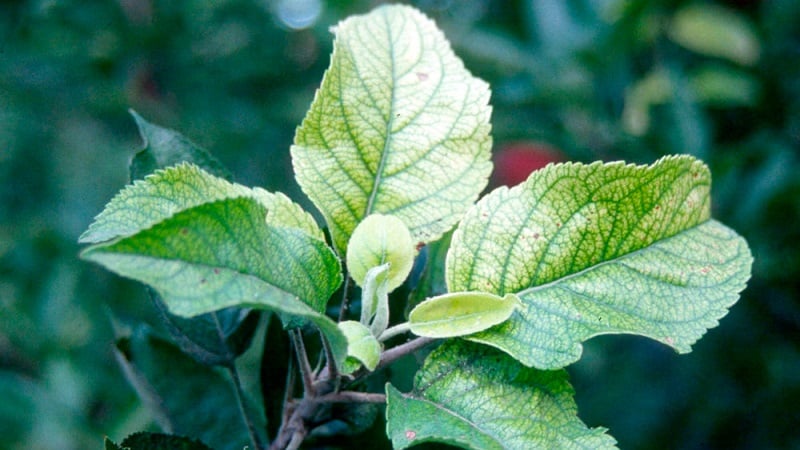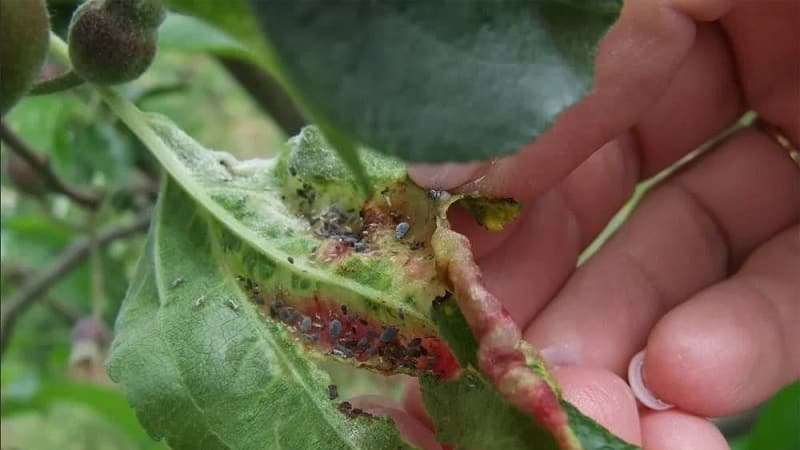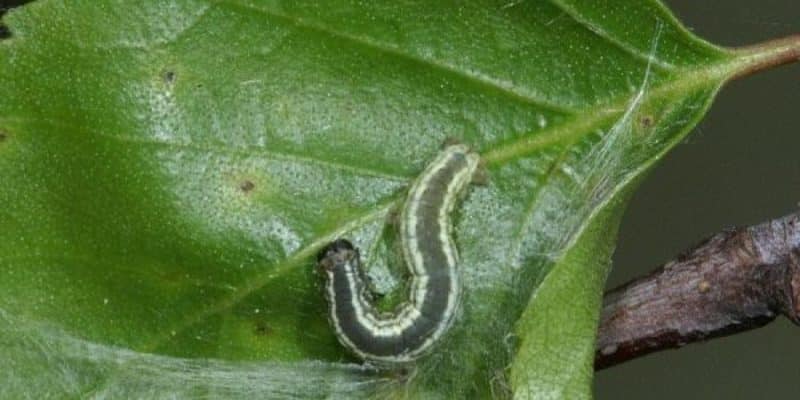The leaves of the apple tree turn yellow in June: what to do and why this happens - a guide for gardeners
In June, the apple tree forms the ovary of the future harvest and continues to grow shoots, so the tree needs nitrogen-potassium fertilizers during this period. They are applied by root and foliar methods - the plant receives nutrients through the roots and leaves. If there are not enough microelements, the tree develops slowly, the shoots dry out and the leaves turn yellow. Also, changes in leaf color can be caused by insect pests, diseases, errors in planting and care. Why the leaves of an apple tree turn yellow in June and what to do about it, we will tell you in the article.
Reasons for yellowing of apple tree leaves in June
Experienced gardeners recommend immediately finding out the cause of yellowing and, depending on it, selecting treatment methods for the tree. The sooner action is taken, the better for the apple tree and yield.
Nutritional deficiencies
An apple tree needs nitrogen, the main element in tree nutrition.. With its deficiency, the plant stops growing, the green mass loses color and fades. The fruits that set do not ripen and become faded in color.
Fertilizing with nitrogen fertilizers is carried out in the spring or early summer, when the apple tree is in the stage of rapid growth. Summer residents use ammonium and sodium nitrate, urea, and ammonium sulfate.

The second most important element in the nutrition of a fruit tree is phosphorus.. Its deficiency affects flowering and fruiting.The growth of roots and young shoots stops, the leaves dry out and turn yellow, the fruits become sour or tasteless. Some trees have red veins on their leaves. In summer, phosphorus is applied through foliar subcortex. Solutions are made based on phosphate rock, double superphosphate, and ammophos.
Yellowing of leaves is also observed due to iron deficiency.. This problem is especially common on calcareous soils. Iron is not absorbed by the plant, which is why the leaves change color, dry out and fall off. Due to microelement deficiency, the apple tree develops chlorosis. It appears first on young and then on adult plants. Treat the apple tree with a chelate solution. To make it, you will need 3 liters of water, 12 g of citric acid and 8 g of iron sulfate.
Interesting website:
Diseases
Diseases occur for various reasons: lack of nutrition, improper care, frequent weather changes, high humidity. Sometimes fungal spores and bacteria enter the plant through gardening tools or with rain and wind. The leaves of the tree turn yellow due to rust, chlorosis, and brown spot.
Rust
The fungal disease loves dense plantings, weeds, and poor soil.. At the first stage, small reddish spots appear on the leaves, which soon increase in size and become orange-yellow. The apple tree loses moisture, becomes weak, and susceptible to other diseases.

Used to treat rust colloidal sulfur solution - 40 g diluted in 5 liters of water. If the disease is in an advanced stage, then gardeners use the preparations “Champion” or “Abiga-Peak”.
Brown spot
The disease spreads in high temperatures and rainy weather.. Development is favored by acidic soil, underground groundwater nearby, and a lack of phosphorus. The leaves are covered with brown-yellow spots with a thin border. The fruits themselves look healthy, but lose their taste.

When brown spot is detected the apple tree is treated with a solution of Bordeaux mixture or iodine.
Chlorosis
Chlorosis causes metabolic disorders and tree wilting. The leaves turn yellow and become covered with dark spots of different diameters. In addition to iron deficiency, the causes of the disease are improper care, magnesium and potassium deficiency, and lack of oxygen.

Treat chlorosis with root dressings - add 25 g of potassium sulfate or 50 g of azofoska (per 1 sq. m). In 5 days spray the tree solution of iron sulfate, after loosening the soil to a depth of 8 cm.
Attention! Chlorosis is easily confused with other diseases such as mosaic or chlorotic ring spot. With mosaic, the leaves are covered not only with spots, but also with stripes of different lengths. With ring spotting, small spots turn yellow and form noticeable rings.
Pests
Pests love weeds and dense plantings. Many of them overwinter in the soil and appear outside only with the arrival of spring. Most insects suck juices from leaves and shoots, which disrupts metabolic processes and causes the apple tree to lose strength and wither.
Apple aphid
Apple aphids love young and succulent leaves, so they appear on the tree in late spring or early summer. The length of the insect is no more than 2 mm; to detect it, you have to carefully examine the leaves. Aphids live in colonies and can destroy not only the harvest of an apple tree, but also other plants in the neighborhood.

Get rid of it using a solution of wood ash - 100 g are stirred in 5 liters of water. Spray leaves and shoots from all sides.
Bukarka
Adult beetles damage shoots and fruits, and the larvae move to the leaves, gnaw small holes in them. Because of this, the leaf blade loses vitamins, becomes deformed and dries out. It is no longer possible to save it; gardeners remove it from the tree and burn it.

Untouched leaves are treated with chlorophos solution. If the larvae do not disappear within two weeks, repeat spraying.
Winter moth
Both green caterpillars and gray-yellow butterflies are dangerous for apple trees.. The pest successfully overwinters in cracks in bark and branches. Appears on trees in summer or autumn. Nibbles leaves, flowers, buds. Gardeners inspect the tree, and if a moth nest is found, they remove it and burn it.

For prevention, the apple tree is sprayed with tobacco solution 2 times a month. - 200 g of dry and crushed tobacco leaves are soaked in 10 liters of warm water.
Agrotechnical errors
Yellowing of foliage can also be caused by agricultural errors.. For example, an apple tree was planted in an acidic and dark area that is constantly blown by winds. Because of this, the tree often gets sick and produces a poor harvest.
Gardeners make mistakes like this too.:
- The apple tree is fed too often, which results in an excess of microelements. It is recommended to observe the frequency of fertilizer application and dosage, and feed the tree no more than once every 3-4 weeks.
- When planting, seedlings and soil are not disinfected; old or diseased planting material is used.
- They plant nearby neighbors that are unsuitable for apple trees - raspberries or gooseberries. Plants do not take root and take nutrients from each other.
- Do not remove weeds in which insect pests live.
- They over-moisten the soil, causing fungal diseases to occur and the roots of the plant to rot.
What to do, how to save a tree
To get rid of problems and save the harvest, summer residents recommend paying attention agrotechnical measures: processing, feeding, pruning. Proper care and treatment guarantee results.
What to do if the leaves fall
If leaves fall and turn yellow, disease may be the cause. It is recommended to remove all damaged leaves and shoots and burn them. If there are many foci of infection, sanitary pruning is carried out. Remove all diseased and dry shoots, as well as young shoots and branches that have no fruit. This is done in the morning using garden pruning shears, pre-treated with a solution of copper sulfate.
Wounds are covered with drying oil or oil paint. The remaining shoots and leaves are sprayed with the preparations “Raek”, “Tiovit Jet”, “Fitolavin”, “Fitomycin”.
5 days after treatment, the soil is fed with organic fertilizers - rotted manure or compost is laid out under the trees. Organic matter nourishes the soil and helps the tree recover faster. For young apple trees, liquid fertilizers are used - 0.5 liters of mullein are diluted in 10 liters of water and the plant is sprayed.
Attention! Beginner gardeners are afraid to prune the plant, believing that this will slow down the development of the fruit. This is not so - a tree pruned on time gives a good harvest and is less sick.
If the leaves turn yellow on a young apple tree
Young plants have fragile immunity. Yellow leaves are a sign of an unsuitable planting site, poor adaptation, sudden weather changes. It is recommended to fertilize the plant with the Rostmoment mineral complex.It accelerates the growth and development of apples and increases resistance to weather conditions. Diluting 5 g of the drug in 10 liters of water, apply it to the root.
Some summer residents prefer folk fertilizers. Wood ash is used - it contains calcium, phosphorus, copper, molybdenum. For 1 sq. m takes 400 g of dry matter. Add ash into special holes located 10 cm from the trunk.

If the problem occurs on seedlings
For landing two-year-old seedlings with a developed root system are used. They are placed in a hole fertilized with organic matter and sprinkled with loose and dry soil. If the leaves turn yellow, then the reason lies in an inappropriate planting site, diseased seedlings, poor soil.
Replanting an apple tree to a new location is dangerous - it is another stress for the plant. That's why it is better to manually remove yellow leaves and add growth stimulants to the soil “Root Super”, “Ribav-Extra” or “Phytoumbrella”. They help seedlings quickly adapt to external conditions, increase productivity and strengthen the plant’s immunity.
Afterwards, the apple tree is mulched - this suppresses the development of weeds and retains moisture. Sawdust, hay, ash, sand, and mown grass are used as mulch. Some gardeners prefer decorative wood chips - they have a beneficial effect on the development of the tree and decorate the garden plot.
Preventive measures
Summer residents regularly spray the apple tree with folk and chemical preparations. The simplest and most effective of them is a solution of wood ash or Bordeaux mixture. The procedure is carried out once every 10-15 days. It helps protect the plant from insects and diseases, many of which cause yellowing of the leaves.
Before fertilizing, the apple tree must be watered - this way the fertilizers are absorbed faster. One tree requires about 10-15 liters of water.The older the apple tree, the higher the consumption. Before watering, loosen the soil so that the water penetrates deeper to the roots and does not evaporate from the surface of the soil.
Attention! For the full development of the tree, summer residents alternate root and leaf, organic and mineral fertilizers. You cannot fertilize an apple tree with only mineral complexes or organic matter - this will weaken the immune system and disrupt metabolic processes.
Advice from experienced gardeners
Experienced summer residents share their tips and tricks that will keep apple trees healthy:
- the pits are prepared 1 month before planting and fertilized with nitrogen-potassium fertilizers;
- the distance between trees must be at least 4 m;
- 25-30 liters of water are used for the first watering;
- the apple tree is pruned once a year (in early spring or summer), the shaping procedure can be carried out in September;
- in hot and dry weather, the tree is watered abundantly;
- in June they use mainly mineral fertilizers;
- regularly inspect the plant for diseases, and if signs are detected, immediately begin treatment.
Conclusion
To protect the apple tree from yellow leaves, it is recommended to follow the rules of planting and care: choose a sunny place, prepare a hole in advance, buy healthy seedlings. Leaves turn yellow for various reasons. The most common are diseases, insect pests, and errors in agricultural technology.
Complex and organic fertilizing, annual pruning, mulching and loosening the soil will help maintain the health of the fruit tree and its productivity. When yellow spots are detected, summer residents use chemical or folk remedies - ash, tobacco leaves, “Raek”, “Rostmoment”.